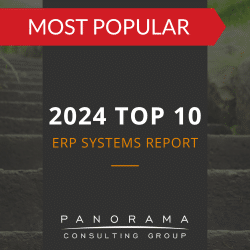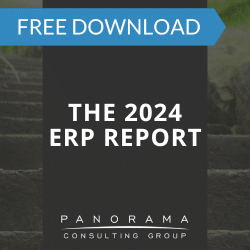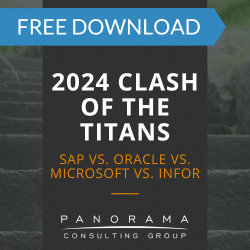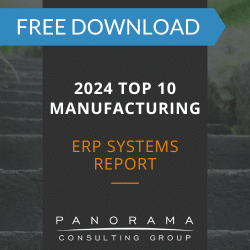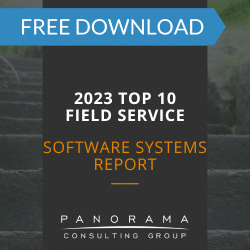What’s one of the most important questions to ask before beginning ERP implementation?
Is our data clean?
If your answer is no, you’re not alone. Most companies have data spread across multiple platforms and formatted in various ways. Our advice to these companies is to cleanse and import data before implementation to ensure their ERP software delivers accurate, real-time data. Proactive data migration also ensures minimal downtime at go-live and reduces the duration of operational disruption.
ERP Selection Guide
This ERP Selection Guide will help you select technology that will support your organization for at least the next ten years.
However, ERP data migration is easier said than done. Most ERP vendors do not take responsibility for data migration or cleansing because it’s extremely costly. Therefore, your ERP project team must take on this responsibility.
Contents
5 Ways Data Issues can Cause ERP Failure
The perfect analogy to describe what an ERP system’s function is for a business is the heart to a human body. If the ERP system is the heart, then data is the blood moving from one part of the business to another – all flowing from and returning to the ERP system.
When data issues exist in your system, there are several ways this can cause ERP failure. Like the importance of blood in the human body, data cleanliness and integrity are essential for a successful ERP project.
Unfortunately, many ERP vendors exclude data migration from their deliverables. As such, it’s not surprising that 41% of respondents in our 2019 ERP Report reported that data issues caused their ERP project to run over-schedule. We also have seen data issues contribute to budget overruns.
1. Your Integrations can Fail
If your business operations rely on partner data, such as shipping information, gift card balances or currency exchange rates, you probably have a few integrations to your enterprise resource planning system. When the data being passed back and forth between your ERP solution and a third party is unclean, it can cause your integrations to fail.
For example, let’s say your shipping methods are “Next Day” and “Standard Ground.” However, your shipping carrier has methods called “Next Day Air” and “Next Day Air Freight.” If your ERP system’s data is too specific (or in this example, not specific enough), the carrier might send back data that your system cannot accept. This will cause any records attempting to be created to error out. Your integration might attempt once more to create the failed records, and the cycle repeats itself. This can cause system performance to decrease and can slow down your ERP implementation process making it run over-schedule. Even though you’ve already gone live, the project recovery process still counts toward your total implementation duration.
We help companies avoid integration issues by preparing them for data conversion before implementation. This preparation involves developing a data strategy, defining the scope of data conversion and determining a data conversion approach.
2. ERP System Performance can Slow
Whether it’s from integrations attempting to repeatedly create records or from batch jobs running and erroring out, bad data can take a toll on your ERP system’s resources. This system lag can be amplified if your transaction volume is large, like during peak times in your business operations.
For example, data issues can cause a batch job to error out. Let’s say that your business runs both its master planning operations and point-of-sales operations through the enterprise system. Master planning is a system-intensive process as it accounts for many different variables like current sales, future orders and current stocking levels. For your point-of-sales operations, your registers and the ERP system need to communicate via a series of batch jobs to push the data back and forth.
If some of your future orders don’t have dates on them, the master planning job can error out. Your ERP system will continue to run the job, allocating more resources to it to balance the load. If your point-of-sales batch jobs start running at the same time, there will be minimal resources allotted to those jobs. As a result, cashiers may experience slower response times or no response at all.
Returning to the analogy of ERP software as the heart of business operations and data as the blood, when a person has a blood clot or blockage, the heart must pump even harder and expend more energy to deliver blood to the body. Sometimes, this can be fatal to a human body (or to a business).
3. Your Customer Satisfaction can Take a Hit
When your system has data issues, your customers notice. This is a data issue that has several prime examples. Consider a returning customer shopping online on your e-commerce site. She wants to buy running shoes to break in for a 5k she is running at the end of the month. She can’t remember what size in your brand fits her, so she looks up her order history to see what size she ordered in the past. Using her name and email she attempts to recall her profile, but the ERP system has duplicate records for her.
Let’s say the customer remembers her size and is ready to order. She checks the inventory levels that your site displays because a quick delivery is a key factor in her buying decision. The product seems to be in stock, so she makes the purchase.
However, it turns out the inventory levels displayed on your site were incorrect because of bad data in your system – your customer will not get her order for another two weeks. If you put yourself in her shoes, would you be a repeat customer?
Once a customer loses trust in your system’s data integrity, it’s nearly impossible to get it back. Consumers today rely on social media and review sites to determine where to spend their money. Disgruntled customers are more than happy to share their unpleasant encounters with the world, preventing you from gaining new customers without even interacting with them.
Improving the customer experience is an important business benefit for many companies. However, some companies do not cleanse their customer-facing data before migration. We recommend discussing data with all departments, so you can understand the various data sources and entry procedures.
If your business hopes to improve the customer experience, you should outline this goal before ERP selection so you can align every component of the project around this goal, especially the data component. Our ERP implementation methodology focuses on organizational alignment as this ensures the ERP software (and its data) support the organization’s goals.
4. Your System can Become Corrupted
Invalid data can cause your ERP system to become corrupted. Whether the data is invalid from a user error or from an automated system update, bad data can wreak havoc on your ERP system and cause functionality to behave unexpectedly.
For example, let’s say your business captures physical dimensions for products in various units of measure. You sell milk in liters and cheese in kilograms. Your ERP system has two item groups – one for liquids and another for solids. If your products are mistakenly assigned to the wrong item group, your cheese could be sold in liters, costing you money by charging much less than the quantity provided is worth.
This single mistake of assigning the wrong item group can cause a chain of downstream issues. When goods are shipped, the system may prompt the user to capture the weight in liters. As a result, all customer- and vendor-facing documentation may display orders for cheese in liters, making it confusing and even a little embarrassing to correct your ERP system’s data mistake.
5. Business Users can Make Bad Decisions
Arguably, the biggest failure that data issues can cause is allowing users to make key business decisions based on bad data. When users believe the system is correct, they don’t hesitate to order ten dozen more corrugated boxes because the warehouse inventory says they have zero on hand.
With bad data being the foundation of user decisions, inventory can be depleted or inflated. The same check to a vendor could be cut twice or not at all, causing your account standing to be damaged. Customers on an “opted out” list could be accidentally emailed by your marketing department and your company could be the target of a lawsuit. While some of these examples sound dramatic, they can be a reality if your ERP system is receiving or pumping out bad data.
Along these lines, once your business users distrust the data in the system, they will forever second guess your ERP system’s accuracy. For example, if a human resources manager denies a pay increase request for an employee because the data in the system says there is no budget, the employee might leave the company. If the human resource manager finds out later that the budget was incorrect, he or she might lose trust in the system’s data integrity.
In some companies, users distrust the data so much that they do their own data validation before making a decision, like exporting data into Excel and doing their own data massaging. This extra step of data validation outside of the system can cause inefficiencies in business processes and lead to low benefits realization.
Our ERP consulting services focus on change management during the data migration process. Designating process owners and data owners not only increases system buy-in, but it improves data integrity as these “owners” are accountable for ensuring data cleanliness and reliability.
11 Data Migration Tips
1. SAP S/4HANA
There is a general misconception that the IT team can handle all the data cleaning. While there is data cleansing software, these packages can only help identify potential areas to be cleansed.
Someone still needs to know, for example, out of two different address records for a company, which one is correct. Also, someone knowledgeable needs to verify that a closing balance is in fact correct.
In most cases, the person who should cleanse these records is not in the IT department but is within the specific department that owns these records. These are called data owners, and they are critical for establishing standards and guidelines to maintain quality data.
IT staff should assist data owners by identifying the data flow, integration points where the data is being updated and what data sources exist.
Examples of Data Needing Cleansing
- Duplicate customer or supplier accounts
- Master data that isn’t classified with a common taxonomy
- Blank description fields for products
- Old product codes no longer in use
- Data for a customer that has gone out of business
- Critical data in Excel that is not in your system of record
2. Remove Duplicate Data
Duplicate items can be identified in two main ways: 1) Direct duplicates include two or more items possessing the same manufacturer name, part number and description. 2) Fit-form-function duplicates include two or more items that possess different manufacturer names and part numbers but have the same fit, form and function.
3. Don’t Migrate All Your Data
Companies continue to persist in the idea that they can migrate all the data from the legacy system over to new ERP software, and the software will somehow magically scrub and standardize it. That’s just not the case.
If you’re moving to a new house, would you put trash and clutter in the moving truck? Probably not, so when you’re moving to a new ERP system, you don’t need to bring over every single piece of data. Some of this data is unclean, unnecessary or pure junk.
The more useless data you bring over, the harder time you will have finding the data you really need, which can delay go-live.
Companies tend to hoard data, believing that someone, somewhere down the line just might need that one nugget of information. An ERP project is a great opportunity to clean house.
4. Determine What Data to Migrate
This can depend on what industry you’re in and your forecasting needs. Determining what data is important should be a collaborate effort that involves all departments.
5. Determine Resource Requirements
You will need developers to convert data and data owners to review and cleanse data. In addition, you may need executives to review certain types of data. Most likely, this will include data elements that relate to the core of the organization’s culture. These may be items your organization has avoided because they seem too hard to address.
Other resources you may need include resources for change management and business process management as you likely will need to train employees on how to input, manage and analyze data once the new system is implemented.
6. Consider Industry Regulations
Different industries have different regulatory requirements. For example, some regulations restrict the ability to change and/or export certain kinds of data records, such as HIPAA with electronic medical records.
You should carefully consider your method of data cleansing (e.g., in-system vs. Excel) if your company has industry-specific regulatory requirements.
7. Consider the Data Complexities of Global Projects
In global ERP projects, you’ll encounter different systems speaking a variety of ERP languages layered on top of cultural and language differences. It is vital to identify these complexities early and communicate to your project team where you see the need for executive decisions. This will eliminate slow periods in the data conversion, allowing developers to stay engaged.
If your project is global, you also will need a signed document from the executive steering committee stating who is responsible for data at the global, regional and country level for both master and transactional data.
8. Define Taxonomies and Attributes
Most ERP systems use some sort of taxonomy to classify items. Master records must be classified correctly, completely and to a level of detail that makes the record easy to identify for search and reporting functions.
While it is not necessary to choose one particular taxonomy, it is necessary to have a taxonomy that supports your company’s business initiatives. Therefore, you should ensure your ERP consultant has experience with taxonomy selection and deployment.
Item record attributes play a similar important role. Attributes define the item and are important for successful parametric searches. Incomplete or incorrect attributes prevent items from being found, resulting in proliferation of parts and bloated inventories.
To ensure a successful ERP data migration project, we recommend extracting, normalizing and completing item attributes beforehand. Because of the sheer volume of attributes to be extracted and enriched, an automated approach is the only practical way to execute this.
9. Develop New Processes
Once the initial data cleansing is complete, you will have more data to cleanse – unless you ensure employees adopt new processes that enable data accuracy. Even though these processes may be designed for legacy systems that will soon be retired, these processes are still worth developing. Consider the fact that most ERP projects last years. Can you endure two more years of dirty data?
We recommend that companies redesign their business processes and train employees both for the future state and this interim state. Both business process reengineering and organizational change management play a critical role in maintaining data cleanliness.
10. Test Before Migrating
Discover if you’re on the right track with your data by moving data to test environments. This will be time consuming and typically requires the development of unique code. Don’t make the mistake of leaving it until the last minute.
11. Use Your Data to Make Business Decisions
With your data migrated, your new processes established and your employees on board, you can almost breathe a sigh of relief – but not quite yet. Now, you must figure out what to do with your data insights.
Companies that have their eye on realizing business benefits from their ERP systems tend to address this issue early with change management and business process management. Knowing that an ERP software solution will enable increased data visibility, forward-thinking companies take advantage of this benefit by establishing data analysis processes. These companies also spend time training employees on these new processes.
Conclusion
Data migration is not usually a priority at the beginning of an ERP project. Instead, the focus is often on planning and design, while data migration is a muddled topic that people tend to avoid.
When companies avoid or delay data migration, their new system will provide unreliable data leading to technical challenges, customer dissatisfaction, low system usage and low benefits realization.
While data migration and cleansing may add cost to an already expensive ERP project, the effort will pay for itself almost immediately through the identification of excess inventory, reduced equipment downtime and improved data insights.
Panorama’s ERP consultants can help your organization develop a data migration strategy that ensures your ERP software provides reliable data to all stakeholders from the minute it goes-live until it’s retired.







